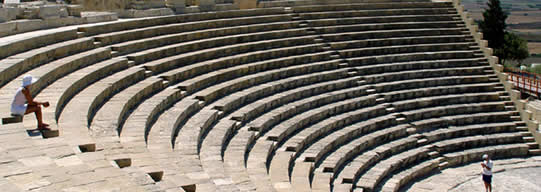
Cypriot history and culture is among the oldest in the Mediterranean. By 3700 BC the island was well-inhabited and a crossroads between East and West. From the 11th Century BC onwards, Cyprus exhibited an essentially Greek culture. The heritage of Hellenism in Cyprus can still be detected in today’s Cypriot Greek dialect which has close affinity to Ioanian Greek from the times of Homer. The island fell successively under Assyrian, Egyptian, Persian, Greek and Roman domination. For 800 years beginning in AD 364 Cyprus was ruled by Byzantium. After brief possession by King Richard I (the Lion-Heart) in 1991 during the Crusades. King Richard, married Berengaria of Navarre in Limassol the same year. The only British Royal wedding which took place outside the shores of the British Isles. His best man was King Leon II of Armenia. King Richard sold the island to the Knights Templar but in 1192 after stife against the Templars, King Richard I transferred the island to Guy de Lusignan, ex King of Jerusalem. The Lusignan era lasted till 1489 and is considerd to be the golden age of medieval Cyprus. Today, the cathedrals and castles still stand as examples of medieval architecture (the two major cathedrals of St. Sophia in Nicosia and St. Nicholas in Famagusta were converted to mosques in 1570). Between 1372 and 1489 the port city of Famagusta was held by Genoa. In 1489 Cyprus was ceded to the Venetian Republic. Shakespeares tragedy “Othello” is set in Famagusta and one can still visit Othellos’s tower there. The Venetian period was marked by expoitation of the people, all they were interested in being strategic issues and their own international trade. The Ottoman Turks conquered Cyprus in 1571. The Ottomans applied the millet system to Cyprus which allowed religious authorities to govern their own non-Muslim minorities. This system reinforced the position of the Orthodox Church and the cohesion of the ethnic Greek population. Most of the Turks who settled on the island during the 3 centuries of Ottoman rule remained when control of Cyprus – although not sovereignty – was ceded to Great Britain in 1878. Many however left for Turkey during the 1920s. The island was annexed formally by the U.K. in 1914 at the outbreak of World War I and became a crown colony in 1925. In 1914, Britain offered to ceded Cyprus to Greece if Greece entered the war on its side; Greece initially preferred to remain neutral, but when it eventually entered the war as a British Ally against Austria-Hungary, Germany and the Ottoman Empire, Britain reneged on the pretext that Greece did not enter the war when the initial offer had been made.
Cyprus gained its independence from the U.K. in 1960 after an anti-British campaign by the Greek Cypriot EOKA (National Organization of Cypriot Fighters) a guerrilla group which desired political union with Greece or enosis . Archbishop Makarios a charismatic religious and political leader was elected president. At this time Greeks constituted 80% of the population whilst Turks made up 18% of it.
Shortly after the founding of the republic serious differences arose between the two communities about the implementation and interpretation of the constitution. The Greek Cypriots argued that the complex mechanisms introduced to protect Turkish Cypriot interests were obstacles to efficient government. In November 1963 President Makarios advanced a series of constitutional amendments designed to eliminate some of these special provisions. The Turkish Cypriots opposed such changes. The confrontation prompted widespread intercommunal fighting in December 1963 after which Turkish Cypriot participation in the central government ceased. UN peacekeepers were deployed on the island in 1964. Following another outbreak of intercommunal violence in 1967-68 a Turkish Cypriot provisional administration was formed.
In July 1974 the military junta in Athens sponsored a coup led by extremist Greek Cypriots hostile to Makarios for his alleged pro-communist leanings and for his perceived abandonment of enosis . Turkey citing the 1960 Treaty of Guarantee intervened militarily to protect Turkish Cypriots.
In a two-stage offensive Turkish troops took control of 38% of the island. Many Greek Cypriots fled south while many Turkish Cypriots fled north. Since then the southern part of the country has been under the control of the Government of Cyprus and the northern part under an autonomous Turkish-Cypriot administration supported by the presence of Turkish troops. In 1983 that administration proclaimed itself the “Turkish Republic of Northern Cyprus”, recognized only by Turkey. UN peacekeeping forces maintain a buffer zone between the two sides. Except for occasional demonstrations or infrequent incidents between soldiers in the buffer zone, there had been no violent conflict since 1974 until August 1996, when violent clashes led to the death of two demonstrators and escalated tension. There is little movement of people and essentially no movement of goods or services between the two parts of the island. Efforts to reunite the island under a federal structure continue, however, under the auspices of the United Nations.
Today, Greek and Turkish Cypriots share many customs and the cuisine but maintain distinct identities based on religion, language and close ties with their respective motherlands. Greek is predominantly spoken in the south, Turkish in the north. English is widely used. Cyprus has a well-developed system of primary and secondary education. The majority of Cypriots earn their higher education at Greek, Turkish, British or American universities. Private colleges and state-supported universities have been developed by both the Turkish and Greek communities.
Source: www.world66.com



